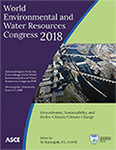World Environmental and Water Resources Congress 2018
The Impact of Artificial Groundwater Recharge on Water Resources Sustainability
Publication: World Environmental and Water Resources Congress 2018: Groundwater, Sustainability, and Hydro-Climate/Climate Change
ABSTRACT
Artificial groundwater recharge (AGR) by flood spreading method is of paramount importance in sustainable management of groundwater resources which increase the natural supply of groundwater and prevents the severe drop in groundwater levels. In this study, suitable areas for artificial groundwater recharge are identified in an aquifer located in Gorveh-Dehgolan Plain using geographic information system (GIS) and analytical hierarchy process (AHP). To achieve this aim; first, the spatial map of seven effective parameters: slope, infiltration, electrical conductivity, alluvial thickness transmissivity, drainage density, and land use were prepared in GIS environment. Next, the maps were weighted using AHP method and overlaid by utilizing GIS analytical function. In next step, the entire aquifer is divided into five areas, each in different sub-basins, and finally the best region for artificial recharge, was selected. The degree of suitability for locating artificial recharge is also shown by mapping the selected region into four classes suitable to unsuitable. Furthermore, in order to evaluate the sustainability status of water resources for the study area, planning for sustainable use index (PSUI) is calculated for current state and for the status of implementing artificial recharge using precipitations with various return periods. This index is based on the water balance parameters which can sufficiently demonstrate impacts of applying artificial groundwater recharge on water resources sustainability including surface water and groundwater. The results of this study show the significant value of utilizing analytical techniques in evaluating the level of artificial groundwater recharge.
Get full access to this chapter
View all available purchase options and get full access to this chapter.
REFERENCES
Asghari, N., Servati, M., Kardavani. P., Shayan. S., (2013). Selection of appropriate locations for artificial aquifer recharge by flood spreading method using AHP method (Case study sarbisheg Gotvand Iran). Geographic Quarterly of the Territory, Year 10, No. 38, Summer 2013.
Bonilla Valverde, J. P., Blank, C., Roidt, M., Schneider, L., & Stefan, C. (2016). Application of a GIS Multi-Criteria Decision Analysis for the Identification of Intrinsic Suitable Sites in Costa Rica for the Application of Managed Aquifer Recharge (MAR) through Spreading Methods. Water, 8(9), 391.
Chowdhury, A., Jha, M. K., & Chowdary, V. M. (2010). Delineation of groundwater recharge zones and identification of artificial recharge sites in West Medinipur district, West Bengal, using RS, GIS and MCDM techniques. Environmental Earth Sciences, 59(6), 1209.
Fetter, C. W. (2001). Applied hydrogeology. 4th. Supplemental website http://www.appliedhydrogeology.info. Upper Saddle River, NJ: Prentice Hall, 598.
Gascó, G., Hermosilla, D., Gascó, A., & Naredo, J. M. (2005). Application of a physical input–output table to evaluate the development and sustainability of continental water resources in Spain. Environmental Management, 36(1), 59–72.
Karamouz, M., Mohammadpour, P., & Mahmoodzadeh, D. (2017). Assessment of Sustainability in Water Supply-Demand Considering Uncertainties. Water Resources Management, 1–18.
Krishnamurthy, J., Venkatesa Kumar, N., Jayaraman, V., & Manivel, M. (1996). An approach to demarcate ground water potential zones through remote sensing and a geographical information system. International Journal of Remote Sensing, 17(10), 1867–1884.
Lal, R. (1994). Methods and guidelines for assessing sustainable use of soil and water resources in the tropics (No. 631.4 L193m). Washington, US: Soil Management Support Services.
Lee, J. O., & Seo, M. (2016). A Study on Optimal Site Selection for the Artificial Recharge System Installation Using TOPSIS Algorithm. Journal of the Korean Society of Surveying, Geodesy, Photogrammetry and Cartography, 34(2), 161–169.
Nasiri, H., Boloorani, A. D., Sabokbar, H. A. F., Jafari, H. R., Hamzeh, M., & Rafii, Y. (2013). Determining the most suitable areas for artificial groundwater recharge via an integrated PROMETHEE II-AHP method in GIS environment (case study: Garabaygan Basin, Iran). Environmental monitoring and assessment, 185(1), 707–718.
Ramalingam, M., & Santhakumar, A. R. (2000). Case study on artificial recharge using remote sensing and GIS. Map India.
Samadi, J. (2016). Site Selection Modeling for Artificial recharge in kashan aquifer using Statistical methods, and groundwater environmental consideration.
Saraf, A. K., & Choudhury, P. R. (1998). Integrated remote sensing and GIS for groundwater exploration and identification of artificial recharge sites. International journal of Remote sensing, 19(10), 1825–1841.
Information & Authors
Information
Published In
World Environmental and Water Resources Congress 2018: Groundwater, Sustainability, and Hydro-Climate/Climate Change
Pages: 92 - 102
Editor: Sri Kamojjala, Las Vegas Valley Water District
ISBN (Online): 978-0-7844-8141-7
Copyright
© 2018 American Society of Civil Engineers.
History
Published online: May 31, 2018
Authors
Metrics & Citations
Metrics
Citations
Download citation
If you have the appropriate software installed, you can download article citation data to the citation manager of your choice. Simply select your manager software from the list below and click Download.
